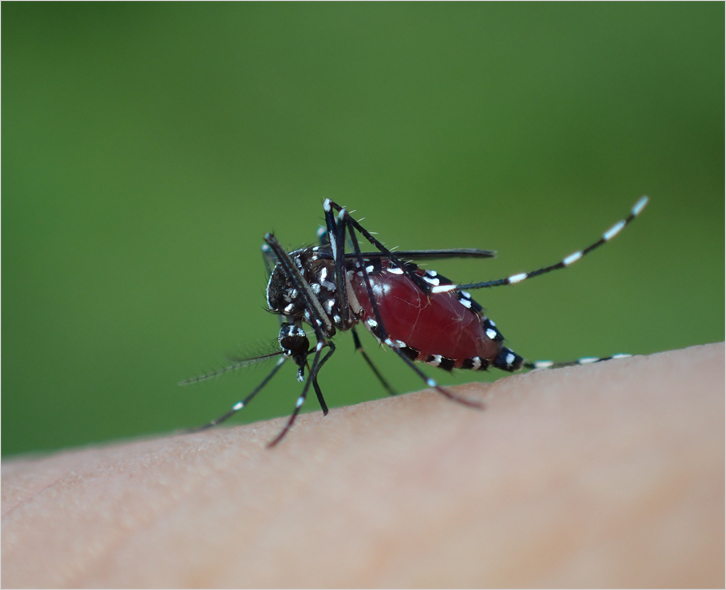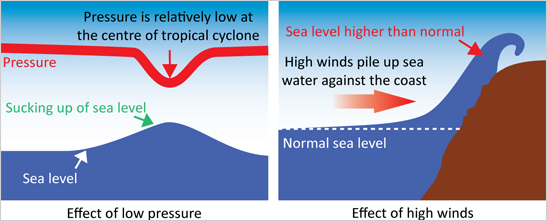The impacts of climate change on humans
1. Health
High temperatures become more frequent due to global warming, with heat waves becoming more frequent and intense with longer duration. High temperatures can induce health problems such as heat stroke or heat exhaustion, increasing the morbidity rate of respiratory diseases and heart cerebrovascular diseases.
| Event | About |
|---|---|
| The 2003 European heat wave |
|
| The 2010 Russian heat wave |
|
| The 2015 India-Pakistan heat wave |
|
★ More Information
Medical alert! Climate change is harming our health
https://medsocietiesforclimatehealth.org/reports/medical-alert/
★ More Information
Climate change already damaging health of millions globally
www.ucl.ac.uk/news/news-articles/1017/311017-climate-change-global-health
★ More Information
Deadly heatwaves could affect more than 70 percent of the world’s population
www.hawaii.edu/news/2017/06/19/rising-deadly-heatwaves/
★ More Information
Deadly heat stress could threaten hundreds of millions even if climate targets reached
www.ljmu.ac.uk/about-us/news/blog/2017/3/28/deadly-heat-stress
Climate warming creates favourable environment for some disease vectors (e.g. mosquitoes) to expand their ranges. Some studies point out that the distribution of mosquitoes will spread to higher latitudes (e.g. the United States, Europe) and higher altitudes, increasing the risk of tropical disease transmission. In addition, bacteria will become more active, threatening human health.

★ More Information
www.thelancet.com/journals/lanplh/article/PIIS2542-5196(17)30156-0/fulltext
Global warming may have positive impacts in certain cold regions as there would be fewer cold related diseases with winters generally becoming warmer. However, research shows that under the business-as-usual scenario of carbon emissions, the negative health impacts of climate change will disproportionately affect warmer and poorer regions.
➤ Warm Arctic, Cold Continents
This topic has been hotly debated among scientists in recent years. The rate of warming in the Arctic is twice as fast as the global average. The rapid Arctic warming affects the westerly jet stream aloft in the Northern Hemisphere and makes it more susceptible to wavy meanders, allowing easier outbreaks of frigid Arctic air to the south. A recent study shows that the warming Arctic has caused colder and snowier winters in the Northeastern U.S. Climate change has made climate forecasting more difficult.
2. Agricultural production
The Fifth Assessment Report viii of Intergovernmental Panel on Climate Change (IPCC) points out that the overall impact of climate change on agriculture is negative while a few studies show that positive impacts are mainly confined in high-latitude regions.
Climate change has more significant negative impacts on the production of wheat and maize while the effect on the yield of soybean and rice is smaller.
For major crops (e.g. wheat, rice, and maize) in tropical and temperate regions, climate change without adaptation is projected to negatively impact production if local temperature increases by 2°C above the late-20th-century levels, although individual regions may benefit.
★ More Information
www.exeter.ac.uk/news/research/title_649617_en.html
The cost of feeding a warming world
3. Risk of coastal inundation by sea water

Many densely populated cities around the world are situated in coastal areas. Rising sea level not only increases the risk of inundation by sea water, but also heightens the threat of storm surges. In addition, some island nations like the Maldives in the Indian Ocean, Tuvalu and Kiribati in the Pacific Ocean are facing the threat of drowning.
Example:
In 2012, Hurricane Sandy hit the east coast of the United States on high tide. The storm surge brought about by Sandy caused extensive damages. In New Jersey, around 350,000 homes were damaged or destroyed, and more than two million people were left with no power supply. The cost of Hurricane Sandy was about 70 billion US dollars.
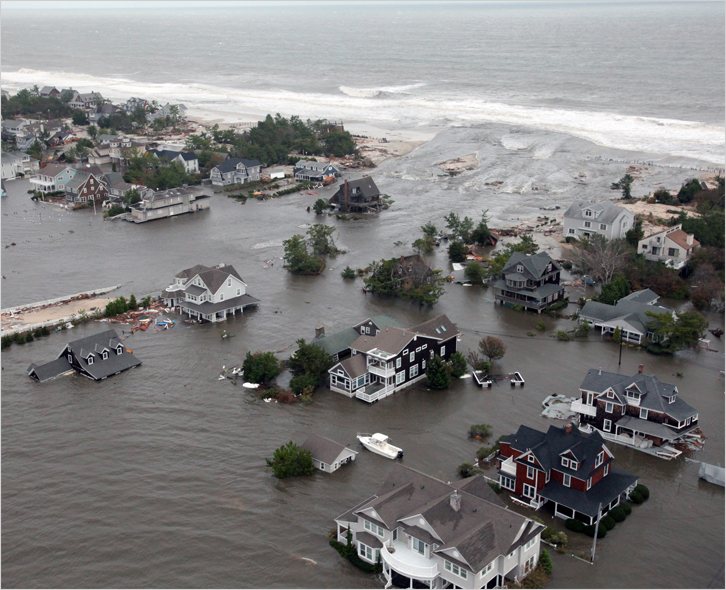 |
|
| Fig 4.14 Storm surge caused by Hurricane Sandy along the east coast of the United States in 2012 ix (Source: Mark C. Olsen, US Air Force) |
★ More Information
4. Water resources
In some areas, decrease of precipitation and increase of evaporation may cause lakes to shrink and river discharge to reduce and hence freshwater resources to decrease. The warming climate accelerates melting of glaciers and ice caps, which may increase freshwater supplies in short term. However, the problem of water shortage will emerge immediately if the glaciers and ice caps melt away completely without replenishment.
As sea level rises, seawater intrusion into rivers and groundwater will increase the salinity of fresh water, making the water not suitable for drinking and irrigation.


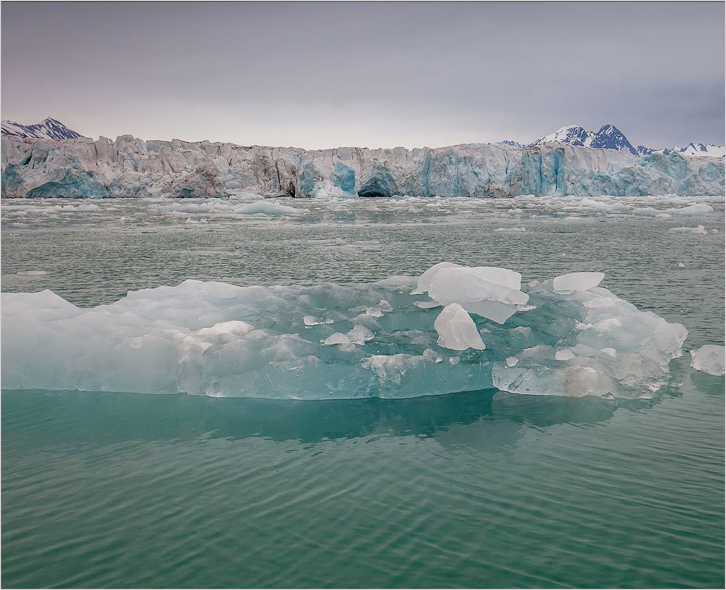 |
|
| Fig 4.16 Melting glaciers in Arctic Svalbard region (2015) (Source: Andreas Weithx) |
★ More Information
http://podcast.rthk.hk/podcast/item_epi.php?pid=643&lang=en-US
5. Infrastructure and transportation
Extreme weather may damage urban infrastructure such as buildings, transport networks, power supply and communication facilities, disrupting normal functions of cities and even causing economic losses. Buildings and infrastructure built on permafrost may be damaged due to the thawing of permafrostxi.
Loss of Arctic sea ice may open up more convenient shipping routes. But, at the same time, it may also lead to more human activities and extraction of resources, in particular fossil fuels, resulting in more pollution and greenhouse gas emissions.
6. Energy supply
Both hydroelectric and thermoelectric power generation (e.g. fossil-fuelled, nuclear) rely on adequate water resources (e.g. rivers). In other words, energy production can be affected by climate change. In addition, thermoelectric power generation facilities need water for cooling. Therefore, the temperature of water will also affect energy production.
It is estimated that more than 60% of power plants worldwide would have production capacity reduced by mid-century due to climate changexii.
As the climate warms, the demand for energy for cooling will increase, making power outages or overloads more likely.
7. Tourism
A number of tourist attractions are disappearing or being damaged as a result of climate change, for example, coral breaching and death in Australia’s Great Barrier Reef. Sea level rise would also destroy tourist facilities in some island countries.
★ More Information
8. National security

The report of US Department of Defense indicates that climate change will aggravate problems such as poverty, social tensions, environmental degradation, ineffectual leadership, weak political institutions and eventually threaten the stability in a number of countries. The report regards climate change as a security risk because it degrades living conditions, human security and the ability of governments to meet the basic needs of their populations. Countries that are fragile and have limited resources are far less likely to respond effectively to challengesxiii.
The government of Sweden sees climate change as a national security issue. In 2018, they distributed a brochure to remind Swedish citizens to be prepared for the crises caused by war and climate change.
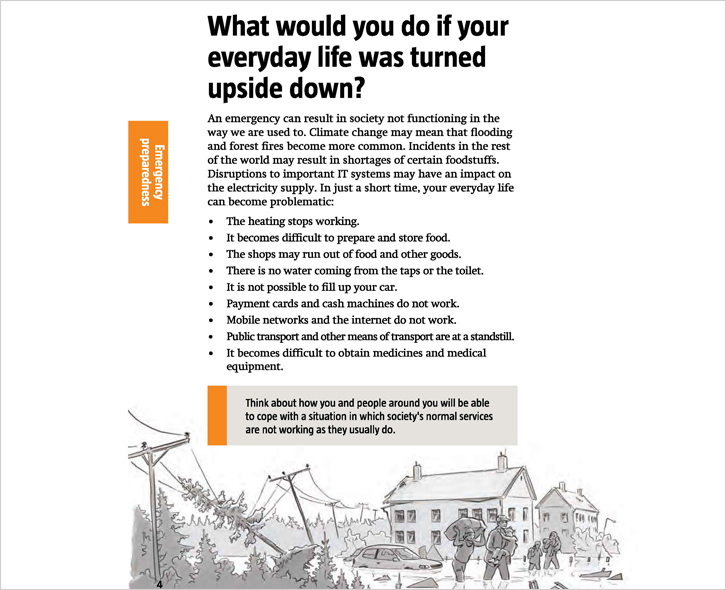 |
|
| 圖4.17 The government of Sweden reminded Swedish citizens to be prepared for the crises caused by climate change (Source: Sweden national security brochurexiv) |
★ More Information
The Fifth Assessment Report of IPCC indicates that the frequency and intensity of drought in the Mediterranean xv may have increased. Since the winter of 2006/07, Syria has experienced a severe drought xvi which led to high food prices. A large number of farmers moved to the peripheries of urban centres where a lot of refugees reside, adding instability to the situation.
➤ Climate migrants
A World Bank report indicates that hundreds of millions of people will move within their countries due to climate change. People of the three densely populated regions: Sub-Saharan Africa, South Asia, and Latin America will be forced to migrate to other places in their countries to build new lives due to impacts of climate change, such as decrease in agricultural productivity, water shortage and sea level rise.
www.worldbank.org/en/news/feature/2018/03/19/meet-the-human-faces-of-climate-migration


